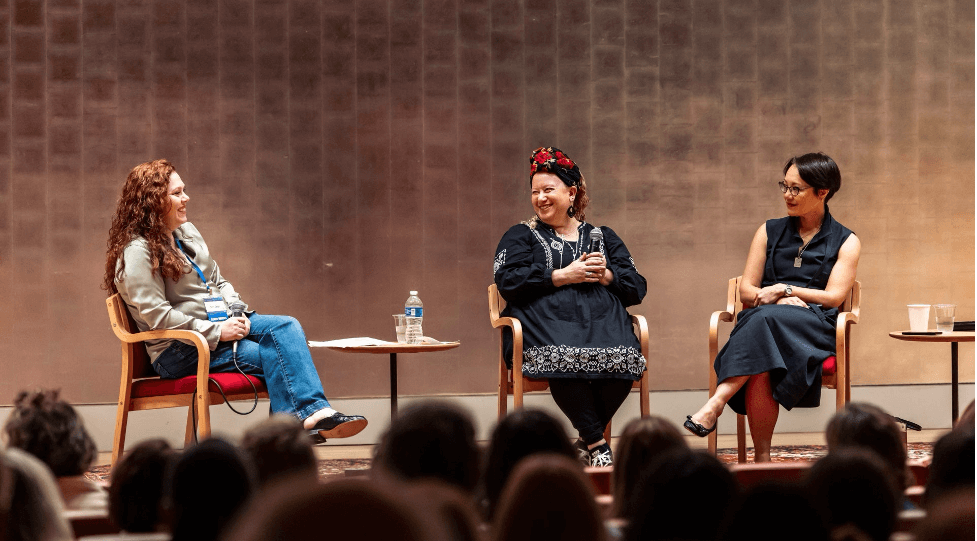Taste Testing ‘The New Kosher’

Graphic by Angelie Zaslavsky
This is an occasional column in which the writer evaluates a new cookbook by making some of its recipes, sharing the dishes with friends and asking her guests what they think of the results. She recently cooked her way through “The New Kosher,” by Kim Kushner.
Related
Cinnamon-Chocolate Pound Cake With Greek Yogurt (below)
The line “I don’t always love to cook” is a funny way to start a cookbook, isn’t it?
But that’s how Kim Kushner introduces “The New Kosher” (Weldon Owen, with photos by Kate Sears). And when I think about it, I realize it’s actually pretty clever. Kushner is likely to endear herself to a lot of readers by sharing that relatable little secret.
As a cooking teacher in New York City, a cookbook author and a mother of three, Kushner shares something else with many of her readers: a busy and chaotic life.
Despite the fact that she is more likely to be cooking against a backdrop of noisy children and a siren roaring past than to an opera soundtrack with a roaring fire in the next room, what Kushner says she loves most of all is “what comes after the cooking part” — which, no doubt, many of her readers will relate to as well.
“I love eating good food, tasting delicious flavors, drinking wine, laughing, learning, connecting,” she writes. “I love the way time stops in those moments, and how I always forget the cooking part.” She lovingly describes watching her family as they savor each bite.
“That is why I cook,” she says.
Kushner was raised in the Modern Orthodox community of Montreal, and her Moroccan-born mother is her greatest culinary influence. And though she attended the Institute of Culinary Education in Manhattan and considers herself a culinary professional, she says “My guests are not my customers; they are my family and friends. My kitchen is not the center of my business, my kitchen is the center of my heart…Cooking serves as a connector, a comfort in my life.”
What Kushner seems to be getting at is that this is a book for those who have much greater pleasures in life than slaving over a hot stove. Many of her recipes require six ingredients or fewer, and sometimes she relies on store-bought condiments like ketchup or Corn Flakes. She describes most of her repertoire in this book as “quick and easy,” and after sampling some of the dishes I would have to agree.
While many recipes indeed sound delicious — and I’ll go back to try out more — the four my friend Elizheva and I made for a recent dinner were somewhat hit or miss. (Elizheva said that she, too, will most likely go back to this cookbook for further inspiration, as she liked the looks of many of the recipes.)
Dishes I’d like to explore in the future include arctic char with wasabi-mirin sauce over rice noodles; hearts of palm, avocado, edamame and za’atar salad; and dark chocolate bark with rose petals, pistachios and walnuts. Others that sound great are lamb rib chops with red wine vinegar, mint and garlic; kohlrabi, edamame and carrots in ginger-miso marinade; and sticky date and caramel bread pudding.
Many of these look easy enough for a weeknight… but I’m getting ahead of myself.
To taste test “The New Kosher,” I enlisted the help of Elizheva, who agreed to take two recipes, while I took the other two, and together we made a Sabbath dinner. We began with a dish Kushner calls “bowl of crack” quinoa, and perhaps that was the problem. As Elizheva’s husband Bob observed, any time you give something the “crack” moniker, expectations are going to be impossibly high.
In this dish, cooked quinoa is mixed with loads of shredded kale, dill, cilantro and parsley and a good dose of citrus and olive oil, with a handful of toasted nuts (we used pine nuts) and golden raisins mixed in. (We all agreed it could have used double the amount of nuts.)
Bob said “This is what I wish tabouli tasted like,” as he often feels he is supposed to like tabouli more than he does. My husband Paulie felt it definitely elevated quinoa, which he thinks can often be quite boring. Bob felt the kale made it a bit too “roughage-y” for his liking — but to each his own. We all agreed that while it was certainly good, it wasn’t addictive enough to live up to its name.
I opted for a kale double-header: For the main dish I made Kushner’s halibut stuffed with kale & feta pesto.
I have to admit I was concerned about making pesto out of raw kale — I would have blanched it first — and even though I love raw kale salad, I did find this treatment a bit too grassy for my liking. The pesto is made from kale, scallions, celery, feta and olive oil. It’s stuffed into slits cut into the halibut before the fish goes into the oven.
I quickly encountered a problem with the directions. Kushner instructs the reader to make the pesto in a mini-food processor, which I attempted to do (against my better judgment). I wondered how all the ingredients would fit into my mini-food processor, (the recipe calls for two cups of raw chopped kale, a celery stalk and other ingredients) and I sensed that all of it wouldn’t fit; I was right. Despite repeated attempts, I had to take everything out and put it in the regular Cuisinart, which made me wonder whether there are different sizes of mini food processors. Also, this is a device that not everyone has…
Tasting it, Elizheva felt the dish needed something more: perhaps a bit of lemon squeezed onto the fish itself. No one really liked the flavor of celery in the pesto. The dish was lovely to look at, with dark green oozing out of the alabaster halibut, and I liked the method of stuffing the fish this way, but if I did it again I’d make a different type of pesto.
To go with the fish, we made Kushner’s Savoy slaw with lemongrass & lime dressing, and took issue with a few things. There was a double-page spread of photos following this recipe: On the left, Kushner is slicing a cabbage by hand; the finished dish is on the facing page. First point of confusion: Kushner is chopping a Napa cabbage; not a Savoy. (Napa are oblong while Savoy are round and wrinkly.) Second, our finished dish looked only vaguely like hers; ours was actually much more colorful, but our cabbage didn’t come out in the nice thin strips that are shown in the photo. Third, Kushner says to shred the Savoy cabbage, carrots and a beet in the food processor. (Julienned sugar-snap peas and salted roasted sunflower seeds are added later.) But in the image, she’s using a knife.
We could understand why Kushner chose to slice her cabbage by hand for the photo, but we wondered why she didn’t instruct us to do the same. While the carrots and beets came out as they should, it turns out that Savoy cabbage does not shred well in the food processor; it came out in tiny bits, which pretty much ruined the consistency of the slaw.
The dressing is what drew us to this dish in the first place: It consists of lime juice, lemongrass, rice vinegar, scallion, coconut oil, olive oil and a bit of sugar — and can also be made in the food processor.
Before we tossed the slaw with the dressing, we passed the bowl around because it made such a beautiful riot of color; we especially loved the slices of snap peas against the beets. Alas, after adding the dressing and tasting the slaw we found that the flavor was much less bright than the colors. (This surprised us, because many of the ingredients in the dressing are quite flavorful on their own. Perhaps there was too much oil for the amount of acid…)
Bob described the slaw as having “interesting flavors that came together to become more bland.” While Elizheva appreciated how easy it was to make — she whipped it up with her three-year-old “helper” Max — none of us could muster much enthusiasm for it.
We felt that adding the sunflower seeds and then the dressing, and letting it rest for 10 minutes as instructed, lessened the nuts’ crunch factor. (As a rule, I toss nuts in after the salad has been dressed, right before serving.)
Luckily, dessert was a highlight. I chose a cinnamon-chocolate pound cake with Greek yogurt. I admit that I fell for the idea that “Greek yogurt in cake makes it healthier,” and while Bob said the consistency reminded him of banana bread, and it tasted somewhat virtuous, the chocolate chunks and cinnamon were a winning combination.
The best possible endorsement, though, came from little Max: He ate his entire piece without a word.
Cinnamon-Chocolate Pound Cake With Greek Yogurt
Makes one 9-inch cake, serves 6-8
1 teaspoon coconut or corn oil
1 1/3 cups (7 ounces) all-purpose flour
1½ teaspoons baking powder
1 teaspoon baking soda
1 heaping teaspoon ground cinnamon
½ cup (4 ounces) unsalted butter, at room temperature
1 cup (8 ounces) sugar
2 large eggs
1 cup (8 ounces) plain or vanilla Greek yogurt
1 cup (5 ounces) dark chocolate chunks
1) Preheat the oven to 350° F. Grease a 9-inch springform pan with the oil.
2) In a bowl, stir together the flour, baking powder, baking soda and cinnamon. Set aside.
3) In a stand mixer fitted with the paddle attachment, beat together the butter and sugar on high speed until smooth, about 3 minutes. Add the eggs and yogurt and beat until combined, about 2 minutes. On low speed, add the flour mixture and beat just until combined. Fold in the chocolate chunks. Pour the batter into the prepared pan.
4) Bake until a toothpick inserted into the center of the cake comes out clean, about 40 minutes. If it is not done, bake for 5 minutes longer.
5) Let cool in the pan on a wire rack for 1 hour before unclasping the pan sides and transferring the cake to a serving plate. Store the cake, covered and in a cool place, for up to 4 days.
Recipe courtesy of Weldon Owen “The New Kosher.”
Alix Wall is a freelance writer and personal chef in Oakland, California. Her blog is theorganicepicure.com
















